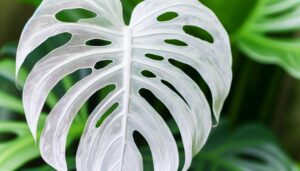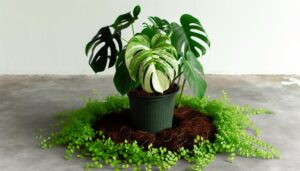Monstera Pinnatipartita Canada
To successfully cultivate Monstera pinnatipartita in Canada, replicate its native tropical rainforest habitat. Position the plant in bright, indirect light, guarantee exposure for 12-14 hours daily.
Maintain an indoor temperature between 18°C to 24°C (65°F to 75°F) and at least 60% humidity. Use well-draining, organic-rich soil, water when the top inch is dry, and adjust watering based on seasonal changes.
Fertilize bi-monthly during growth phases with a balanced N-P-K ratio. Propagate using 6-inch stem cuttings with nodes.
Monitor and adapt your care to prevent root rot and ensure healthy foliage. Discover more about seasonal care and propagation methods next.

Key Takeaways
- Monstera Pinnatipartita thrives in bright, indirect light with 12-14 hours of light daily.
- Maintain 60% relative humidity and temperatures between 18°C and 24°C.
- Water every 7-10 days, adjusting based on humidity and growing season.
- Use well-draining soil with peat moss, perlite, and pine bark, and apply balanced N-P-K fertilizer bi-monthly.
- Propagate using 6-inch stem cuttings with nodes, keeping them in water or moist sphagnum moss.
Origin and Characteristics
Monstera pinnatipartita, originating from the tropical rainforests of Central and South America, exhibits deeply lobed foliage that matures into fenestrated leaves, making it a striking specimen in any botanical collection.
You'll notice its juvenile leaves are entire and heart-shaped, evolving into pinnately divided leaves as they mature. This morphological change is an adaptation to increase light capture in dense forest understories.
Its aerial roots, which emerge from the nodes, help anchor the plant to surrounding structures, facilitating its climbing habit.
The Monstera pinnatipartita's inflorescence consists of a spadix surrounded by a spathe, typical of the Araceae family. Understanding these characteristics aids in identifying this species and appreciating its unique evolutionary adaptations within its native habitat.
Ideal Indoor Conditions
To cultivate Monstera pinnatipartita successfully indoors, make sure you provide bright, indirect light to mimic the dappled sunlight of its native rainforest understory. The plant thrives best in environments with high humidity and consistent temperatures. Guarantee the soil is well-draining and rich in organic matter to prevent root rot and support nutrient uptake.
Key conditions to maintain include:
- Humidity: Maintain at least 60% relative humidity to replicate its natural habitat.
- Temperature: Keep the ambient temperature between 18°C and 24°C (65°F to 75°F) for peak growth.
- Watering: Water when the top inch of soil is dry, ensuring the soil remains damp but not waterlogged.
Light Requirements
When considering light requirements for Monstera pinnatipartita, make sure it receives bright, indirect sunlight to mimic its natural understory habitat.
You should use sheer curtains or position the plant near east-facing windows for best photosynthesis.
Adjust indoor lighting during seasonal changes to maintain consistent light exposure, important for its physiological processes.
Optimal Sunlight Conditions
Although Monstera pinnatipartita thrives in bright, indirect light, it can tolerate lower light conditions, making it adaptable to various indoor environments.
To ensure optimal growth conditions, consider the following:
- Photoperiod: Aim for 12-14 hours of light daily to mimic natural tropical conditions.
- Light Intensity: Provide 10,000 to 20,000 lux, which replicates dappled sunlight found under a forest canopy.
- Light Quality: Utilize full-spectrum grow lights if natural light is insufficient, ensuring a balanced wavelength distribution.
Monstera pinnatipartita, with its fenestrated leaves, benefits from avoiding direct sunlight, which can cause photodamage (chlorophyll degradation). Lower light conditions might slow down growth but won't hinder its overall health.
Understanding these light parameters will help you cultivate a robust, healthy plant.
Indoor Lighting Tips
Ensuring Monstera pinnatipartita receives appropriate indoor lighting involves strategically positioning the plant to simulate its natural habitat's light conditions. Place it near an east-facing window where it can receive bright, indirect sunlight. Direct sunlight may cause chlorophyll degradation, leading to leaf scorch.
If natural light isn't sufficient, use full-spectrum grow lights, ensuring a luminous flux of 10,000-20,000 lux. Monitor leaf morphology; yellowing may indicate excessive light, while leggy growth suggests insufficient light. Rotate the plant periodically for even light distribution, promoting uniform photosynthesis.
Avoid placing it near heat sources, as Monstera pinnatipartita prefers stable temperatures. By mimicking its native understory environment, you'll foster healthy fenestration and robust growth.
Seasonal Light Changes
As the seasons change, adjust the positioning and duration of artificial lighting for your Monstera pinnatipartita to compensate for reduced natural light, maintaining consistent growth and fenestration.
During winter, the decrease in photoperiod can hinder chlorophyll synthesis and overall plant vigor. Increase light exposure by following these steps:
- Intensity: Use grow lights that emit a full spectrum, providing at least 2000-3000 lux.
- Duration: Extend the light period to 12-14 hours daily to emulate longer daylight hours.
- Positioning: Place lights 12-18 inches above the canopy to prevent light burn while maximizing coverage.
Monitor leaf coloration and growth patterns closely. Adjustments guarantee your Monstera pinnatipartita maintains its striking pinnatifid leaves year-round.
Watering Schedule
Monitoring the moisture levels in the soil is crucial for maintaining the health of your Monstera pinnatipartita. Aim to keep the soil consistently damp but not waterlogged. Overwatering can lead to root rot, a common issue with Monstera species. Use a moisture meter to gauge soil hydration accurately.
Typically, water your Monstera pinnatipartita every 7-10 days, adjusting based on seasonal changes and indoor humidity levels. During the growing season, you may need to increase frequency, while in dormant periods, reduce watering. Ensure that the pot has adequate drainage, preventing water from stagnating at the roots.
Soil and Fertilizer
A well-draining soil mix enriched with organic matter, like peat moss and perlite, ensures Monstera pinnatipartita roots receive sufficient oxygen and nutrients. This is crucial for preventing root rot and promoting robust growth.
To enhance your soil mix, follow these steps:
- Combine equal parts peat moss, perlite, and pine bark: This mixture guarantees excellent drainage and aeration.
- Incorporate a slow-release fertilizer: A balanced N-P-K ratio (e.g., 10-10-10) supports consistent nutrient supply.
- Use mycorrhizal fungi: These beneficial microbes improve nutrient uptake and root health.
Monitor soil pH, ideally around 5.5 to 6.5, for optimal nutrient absorption. Apply liquid fertilizer bi-monthly during growing seasons, but reduce frequency in winter.
Your Monstera pinnatipartita will thrive with this soil and fertilizer routine.
Pruning Techniques
Pruning Monstera pinnatipartita involves strategically removing dead or overgrown foliage to maintain plant health and encourage new growth.
First, sterilize your pruning shears to prevent pathogen transmission.
Identify leaves with discoloration or necrotic tissue; these should be removed at the base. For overgrown vines, cut just above a node to stimulate lateral growth.
Make sure cuts are clean and avoid tearing the plant's tissues, which can invite infection.
Observe the plant's natural growth pattern; Monstera pinnatipartita has pinnatifid leaves, and improper pruning can disrupt this morphology.
Regular pruning not only enhances aesthetic appeal but also improves light penetration and air circulation, essential for photosynthetic efficiency.
Always monitor the plant's response post-pruning to adjust techniques as necessary.
Common Pests and Diseases
Maintaining a healthy Monstera pinnatipartita through proper pruning also helps in mitigating common pests and diseases like spider mites (Tetranychus urticae) and root rot caused by Phytophthora species.
Spider mites are tiny arachnids that can cause stippling and discoloration on leaves, leading to reduced photosynthesis. To manage these pests:
- Regularly inspect leaves: Look for fine webbing and tiny moving dots.
- Increase humidity: Spider mites thrive in dry conditions.
- Use miticides: Apply as per instructions for effective control.
Root rot, a serious disease caused by Phytophthora species, results in mushy, decayed roots. Ensure adequate soil drainage and avoid excessive watering to prevent this condition. Regularly check the roots for signs of infection and prune any affected parts immediately.
Propagation Methods
To propagate Monstera pinnatipartita, you can use stem cuttings, making sure each cutting includes a node where new roots will develop. Cuttings should be about 6 inches long, with at least one leaf. Place the cutting in water or moist sphagnum moss, making certain the node is submerged. Roots typically appear within 2-4 weeks. For best results, maintain humidity around 70-80% and temperatures between 20-25°C.
Here's a quick reference table to assist:
| Method | Medium | Time to Root |
|---|---|---|
| Stem Cutting | Water | 2-4 weeks |
| Stem Cutting | Sphagnum Moss | 3-5 weeks |
| Stem Cutting | Perlite | 3-6 weeks |
| Stem Cutting | Potting Mix | 4-6 weeks |
This detailed approach guarantees successful propagation of Monstera pinnatipartita.
Seasonal Care Tips
Regularly adjusting your care routine for Monstera pinnatipartita with the changing seasons assures the plant thrives throughout the year. During winter, make certain Monstera pinnatipartita receives adequate indirect light. As daylight diminishes, supplement with grow lights.
In spring, increase watering frequency as the plant enters its growth phase. Summer demands higher humidity levels, so mist the leaves or use a humidifier.
- Winter Light: Use full-spectrum LED grow lights to compensate for reduced natural light.
- Spring Watering: Gradually increase water supply to support new growth.
- Summer Humidity: Maintain humidity between 60-70% using a humidifier or pebble tray.
In autumn, reduce watering and feeding to prepare the plant for dormancy, mirroring its natural tropical habitat conditions.
Conclusion
Imagine your Monstera pinnatipartita thriving in your Canadian home, its lush, fenestrated leaves cascading gracefully.
You've mastered its care, ensuring it receives bright, indirect light, consistent watering, and nutrient-rich soil.
By pruning strategically and tackling pests like spider mites and aphids, you've fostered a healthy environment.
Propagation through stem cuttings promises new growth.
With each season, adapt your care, and watch this tropical beauty flourish, transforming your space into a verdant sanctuary.






